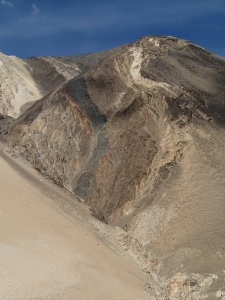The wifi was back to its usual state this morning so no luck sending my email or posting another blog. Everyone seemed on good form at breakfast and we left for Pangong at 9, after a brief talk from John about the geology we’d see on the way and from me about health and safety stuff related to the altitude at Chang La. We stopped to pick up a box of beer at Karu as the drivers were sweetly concerned we’d have to pay above the odds for it at Pangong.
The road seemed rougher and more bumpy than last year – a bit of a white knuckle ride, to be honest! The road surface has obviously been damaged by melting snow and there was water running across it in many places, especially as we neared the top. We had a very short stop at Chang La for photos. Sadly it was quite cloudy, so the views were nowhere near as spectacular as last year, which helped us persuade people not to linger.
Chang La Pass and the view towards the Zanskar range
We were all greatful for the somewhat cooler weather for travelling though. There were deep snow pockets above the road as we climbed and we could see where there had been a big avalanche on the large North-facing snow field near the pass.
Avalanche above Chang La
We all pretended to ignore the fact that we’d seen three army lorries in the valley bottom which had obviously come off the road some time over the winter. We dropped down a couple of thousand feet and stopped beside a small lake for lunch – at first it was cold, with a threat of rain or sleet, but then the sun came out and it was beautiful.
We had a look at some of the saxifrage cushion plants and were able to show that the temperature at the centre of the cushion was always a degree or two less than on the outer edges, protecting the meristems from overheating at this time of year. We found some uprooted cushions too and it was intriguing to see how they are attached to the ground by a single, robust tap root.
Cushion plants
The lichens here were much more dominated by red and orange species, including Xanthoria. Those more interested in the geology found abundant pieces of a bright yellow-green mineral here, possibly serpentine.
After lunch we drove down the spectacular valley to Pangong Tso. At a brief stop for the geologists to admire the beautifully-coloured metamorphic rocks, we also saw plenty of yellow Clematis in flower as well as a honeysuckle with tiny flowers.
Cloudy skies meant Pangong itself was less spectacular than when we arrived last year but still very beautiful with its backdrop of marbled metamorphic mountains.
We decided a more apt name for our accommodation than Camp Shambala might be Camp Shambles, though. They offered us tea while sorting out our tents – one had someone else in the bed when the door was unzipped and they didn’t have a tent for me on the same site as everyone else. The tents have comfortable beds and each has its own sink and toilet but some people had been expecting something a little more luxurious. Others, however, liked the fact that most of the guests were Indian rather than foreigners.
While waiting for the tents to be sorted out, we had a very pleasant wander along the lake, skimming stones and looking at the tiny plants on the shore. John had serious competition in stone skimming, for once! Dinner was a fairly basic buffet but we enjoyed beer round a lovely campfire built by the drivers afterwards. One really good thing is that no-one appears to be suffering from the effects of altitude.
The drivers reappeared suddenly, just after 10 pm, to tell us that the generators would be switched off shortly so everyone headed off to bed promptly. Disappointingly, the sky was too cloudy to permit much in the way of stargazing.










